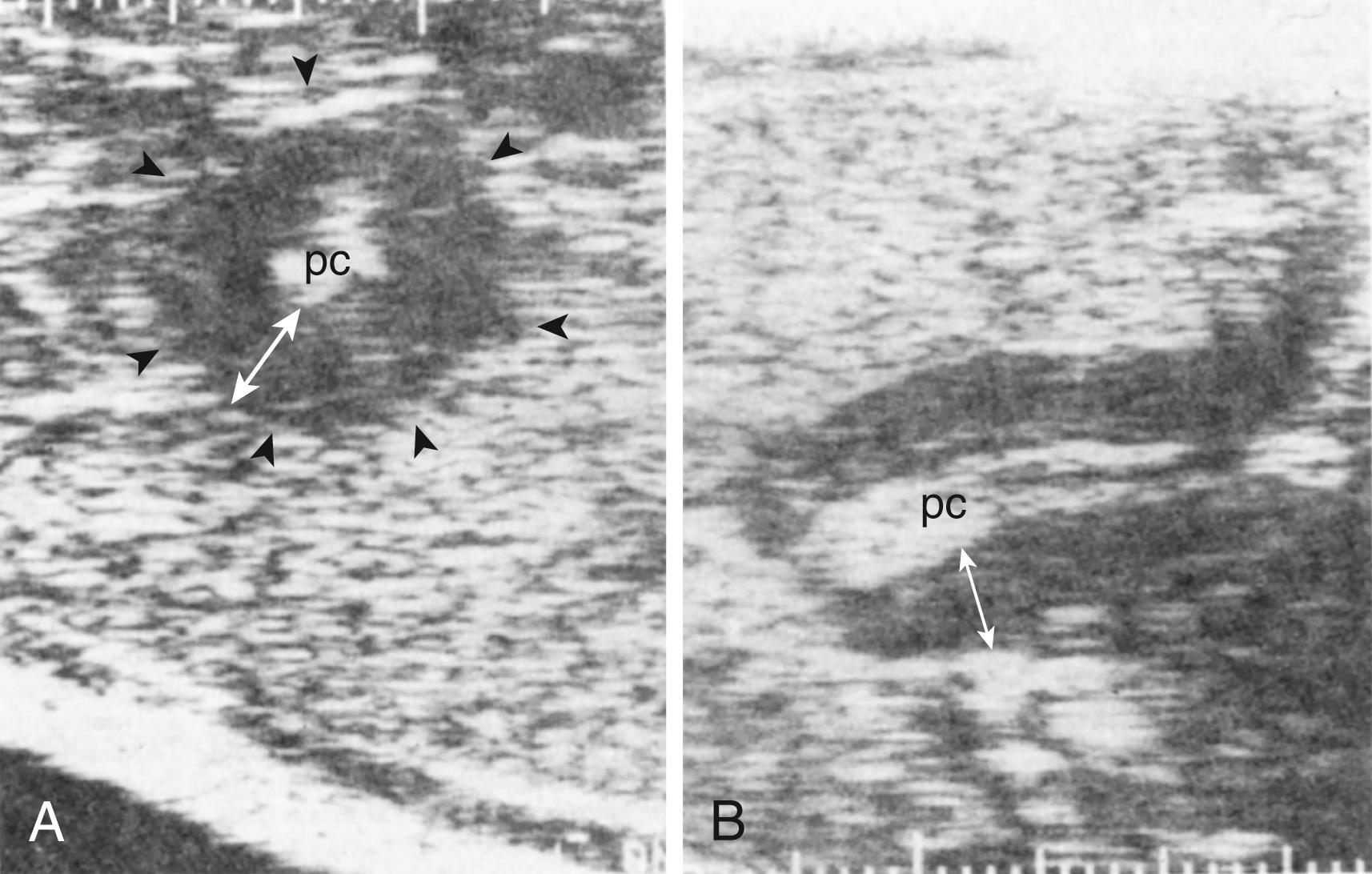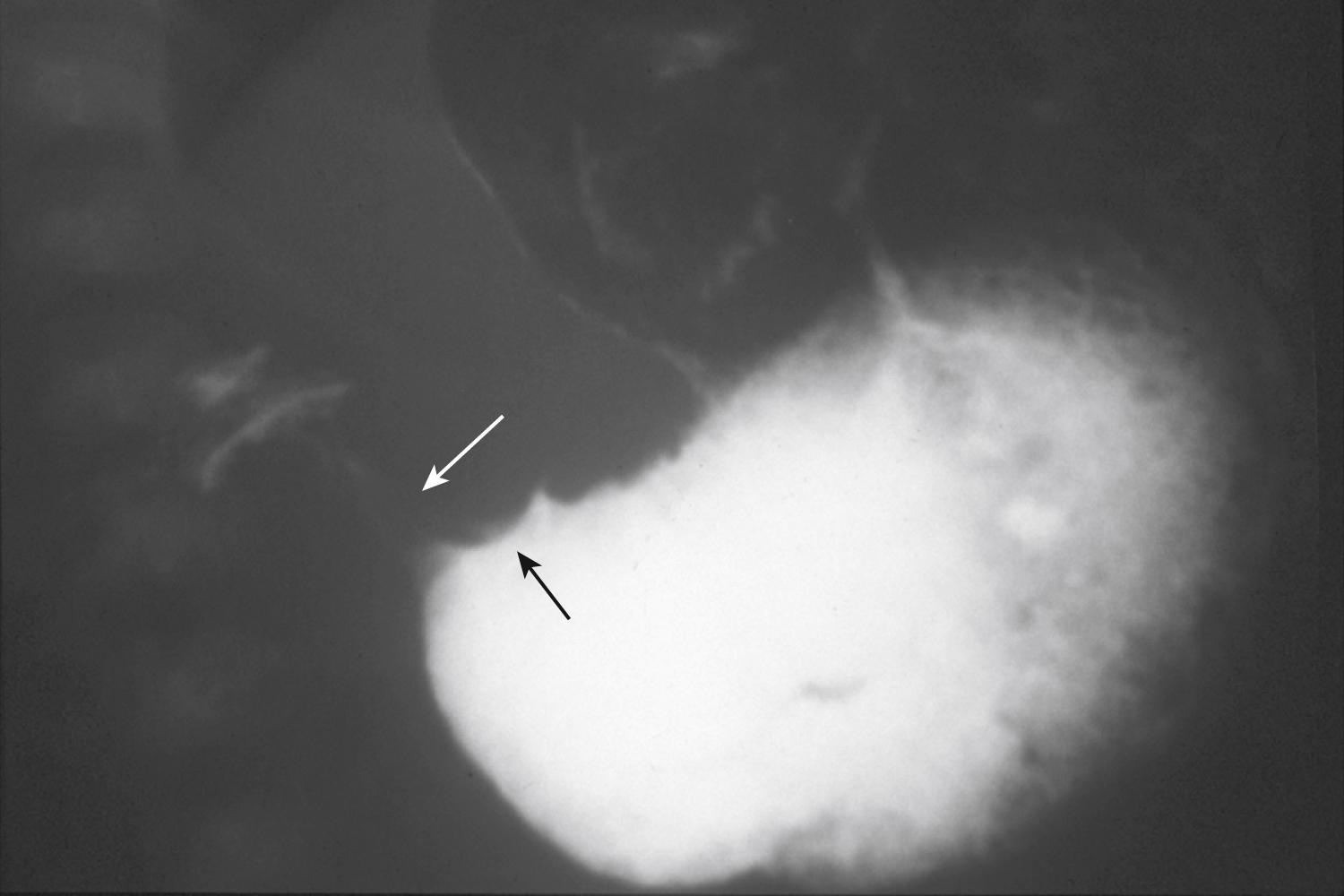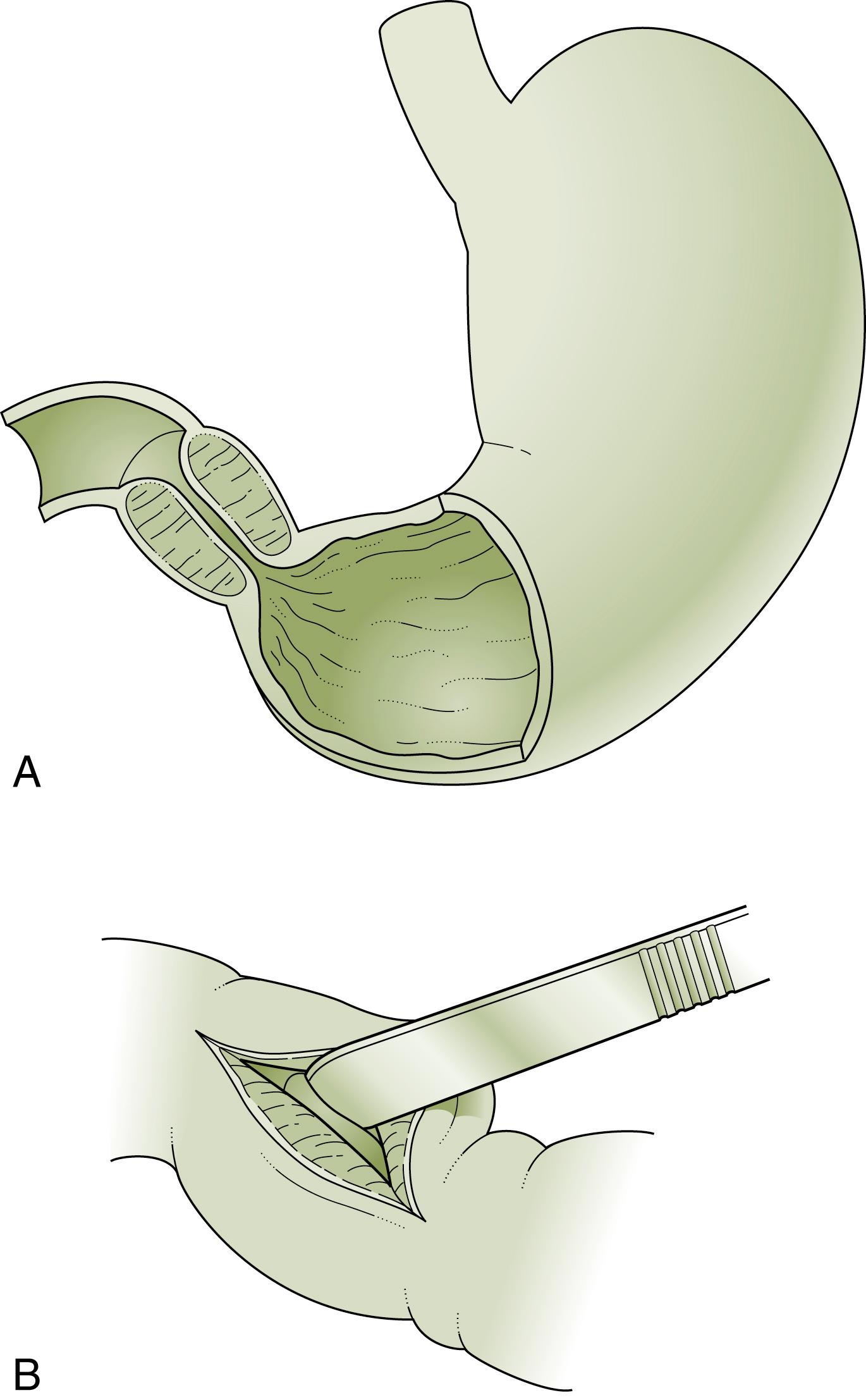Physical Address
304 North Cardinal St.
Dorchester Center, MA 02124
We thank Louisa W. Chiu, MD, for the authorship of the chapter from the fourth edition.
A general understanding of the embryologic development of the stomach is essential to the management of congenital and acquired surgical disorders of the stomach. The primordial stomach is a foregut organ that begins as a pharyngeal structure and then dilates and elongates to form the esophagus and stomach. The dorsal border of the primordial stomach grows faster than the ventral border, resulting in the greater and lesser curvature, respectively. By the end of the seventh week of gestation, the stomach has undergone rotation around both the vertical and anteroposterior axes to come to rest in its normal anatomic position (see also Chapter 24 ).
Hypertrophic pyloric stenosis (HPS) is the most common gastric surgical disorder in neonates. It was first described clinically by Hildanus in 1627, with subsequent accounts provided by Blair in 1717, Beardsley in 1788, and others. Not until 1888 was the disease generally appreciated following Harald Hirschsprung’s description with postmortem clinicopathologic correlation and introduction of the term congenital pyloric stenosis . The first surgical treatment performed by Löbker in 1898 was a gastroenterostomy bypass of the pyloric obstruction. Extramucosal splitting of the muscle with transverse pyloroplasty was demonstrated by Dufour and Fredet in 1908, and then modified to solely a muscle-splitting procedure by Ramstedt in 1911. Ramstedt’s pyloromyotomy became the procedure of choice in the early 20th century. ,
The prevalence of HPS ranges from 1.5 to 4.0 per 1000 live births and varies with geographical region. , In the United States it is more prevalent in Caucasian populations compared with African Americans or Asians. Multiple studies focusing on epidemiologic developments have found divergent results; although numerous studies have claimed trends in prevalence of HPS, epidemiologic studies suggest that the prevalence has been stable over time. The ratio of males to females remains constant at approximately 4:1, with increased risk to first-born infants. The prevalence of a positive family history demonstrates the polygenic mode of inheritance; the children of mothers who had pyloric stenosis are more likely to have the anomaly than are children of fathers who had the disease. ,
HPS is a result of progressive hypertrophy of the circular muscle, leading to a temporary high-grade or complete gastric outlet obstruction.
Despite considerable research efforts, no single etiology has been identified for HPS. Genetic as well as environmental factors seem to contribute to the pathophysiology. Environmental investigations found a potential influence of method of feeding, erythromycin treatment, maternal smoking, and infant sleeping position on development of HPS. , , A genetic predisposition seems beyond question; strong familial aggregation supports this theory. Genetic studies in individuals with isolated HPS have identified chromosomal regions linked to the condition, but these associations could not be confirmed in subsequent cohorts, suggesting considerable genetic heterogeneity. So far, five genetic loci have been identified as being associated with the development of HPS. One of them encodes the nitric oxide synthetase, a key player in smooth muscle relaxation. , Other theories revolve around hyperacidity leading to spasms and edema, abnormal innervation, reduction of neurotrophins, growth factors and gastrointestinal peptides, and abnormal motility.
The typical patient presents between 3 and 6 weeks of age. Premature infants may show clinical findings at an older age. Parents provide a history of prolonged emesis that has progressively become more forceful and “projectile.” The emesis is nonbilious but may become brown-colored or have blood streaks due to minor mucosal hemorrhage from gastritis. Emesis occurs soon after feeds, and the infant will usually appear hungry following emesis. Often several formula changes have been made by the parent or pediatrician prior to workup for HPS. A prolonged period of vomiting may lead to dehydration, lethargy, weight loss, and failure to thrive. Decreased urine output and hypochloremic, hypokalemic metabolic alkalosis develop in tandem as a result of depletion of sodium, potassium, chloride, and hydrogen ions. The ability of the kidneys to maintain a normal pH by excreting bicarbonate is impaired by the low chloride levels. Excess bicarbonate is instead reabsorbed to maintain electrochemical neutrality, which exacerbates the alkalosis. In response to hypovolemia, aldosterone is secreted leading to renal absorption of sodium ions. In an attempt to conserve sodium at the expense of hydrogen ions, paradoxical aciduria may occur late in the process. Jaundice due to unconjugated hyperbilirubinemia is found in 1% to 2% of infants and is believed to be secondary to starvation, an immature liver, and decreased levels of glucuronyl transferase activity. The jaundice usually resolves after surgery. The differential diagnosis of nonbilious vomiting at this age includes overfeeding, gastroesophageal reflux, pylorospasm, increased intracranial pressure, infectious gastroenteritis, metabolic disorders, and other uncommon causes of gastric outlet obstruction.
Rarely, the diagnosis of HPS can be made by physical examination alone in the setting of an appropriate history. Signs of dehydration and a palpable olive-shaped mass in the epigastric region under the liver’s edge are the cardinal physical findings. We advocate early ultrasonographic investigation to avoid potentially stressful and frequently unsuccessful examinations for patients and parents. The characteristic appearance of pyloric stenosis on ultrasonography is a target sign consisting of an outer ring of low-echo-density musculature and an inner ring of high-echo-density mucosa. A pyloric thickness greater than 3.5 to 4 mm and a length of 16 mm are widely accepted as diagnostic criteria for pyloric stenosis. An ultrasound exam by trained technicians is 100% sensitive and 99% specific for HPS with measured thicknesses of 3 mm or greater; pyloric lengths of 15 mm or greater had a 100% sensitivity and 97% specificity, independent of patient age and weight ( Fig. 25.1 ). , ,

Often the sonographer can comment on whether there is passage of gastric contents during the period of examination, which—if negative—further substantiates the diagnosis. Given that ultrasonography is accurate, noninvasive, cost-effective, and without risk of contrast aspiration, it has replaced the upper gastrointestinal (UGI) series as the gold standard for imaging diagnosis of pyloric stenosis. In the event of a nondiagnostic ultrasound, a UGI series may differentiate between pyloric stenosis and other possible causes of nonbilious emesis, such as gastroesophageal reflux and antral or pyloric webs. On UGI, the narrowed pyloric channel of HPS produces a “string sign” of contrast; a “double track” sign illuminates the infolding mucosa, and a “shoulder sign” is caused by the muscle bulging into the distal antrum ( Fig. 25.2 ). ,

Treatment of HPS itself is never a surgical emergency, but it may present as a medical emergency due to accompanying hypovolemia and electrolyte disturbances. The goal of initial therapy is to correct the dehydration and metabolic alkalosis before surgery. This requires rapid analysis of electrolytes and establishment of intravenous (IV) access. IV fluid resuscitation is initiated with boluses of 10 to 20 mL/kg of 0.9% normal saline to correct hypovolemia. Thereafter, an IV infusion of 5% dextrose in 0.45% saline is begun at 1.5 times the maintenance rate. Once urine output is established, 10 to 20 mEq/L of potassium chloride can be added to the infusion. , Most infants with HPS can be resuscitated within a 24-hour period. Aggressive resuscitation should be avoided in patients with severe electrolyte and fluid abnormalities to avoid rapid fluid and electrolyte shifts putting the child at risk for seizures and other complications. Depending on the severity of initial presentation, electrolyte levels should be checked every 12 hours until they are normalized. The infant should be maintained on strict fasting. NG tube suction should be avoided, because it will only further contribute to electrolyte disturbances.
Adequate resuscitation prevents postanesthetic intraoperative hypotension and postoperative apnea. Many pediatric anesthesiologists will request a chloride level greater than 100 mmol/L and serum carbon dioxide less than 28 mmol/L before general anesthesia. , Immediately before induction, the stomach should be aspirated with an orogastric tube, especially if the infant previously underwent a UGI contrast study.
Standard surgical correction of HPS is a muscle-splitting longitudinal extramucosal pyloromyotomy using an open or minimally invasive approach ( Fig. 25.3 ). The open pyloromyotomy initially was described through a 2- to 3-cm right upper quadrant (RUQ) incision and is performed today by most surgeons via a supraumbilical curved incision introduced by Tan and Bianchi in 1986. With advantages in laparoscopic surgery, many pediatric surgeons prefer the laparoscopic pyloromyotomy, as first described by Alain et al. in 1991, with an umbilical incision and two stab incisions (see Fig. 25.3A and B ). Regardless of the means of access, the elements of the procedure are the same. The serosa and outer muscle fibers are incised from proximal to the pyloroduodenal transition to the antropyloric junction on the stomach. The deeper muscle fibers are bluntly split with the handle of the scalpel (open) or a shielded, extended cautery blade or retractable laparoscopic blade. A Benson or laparoscopic pyloromyotomy spreader is used to complete the muscle-splitting to the level of the submucosa. Adequacy of the pyloromyotomy is ensured with the two muscular cutting edges independently moving. Great care should be applied at the distal portion of the pyloromyotomy at the pyloroduodenal junction, as it bears the greatest risk for a mucosal tear and full-thickness myotomy into the lumen. After completion of the pyloromyotomy, the stomach can be insufflated with 45 to 60 mL of air with use of an orogastric tube to check for an air leak or evidence of bilious fluid that would be indicative of a mucosal injury. A full-thickness enterotomy can be repaired primarily with absorbable sutures of the initial myotomy and an omental patch. A new pyloromyotomy can then be made on the opposite side.

A nonlaparoscopic, transumbilical, intracavitary pyloromyotomy variation combining the advantages of open and laparoscopic techniques has been described by Gauderer. Evolving surgical techniques include microlaparoscopic pyloromyotomy applying 2.0 mm instruments and a 1.7 to 2.4 mm endoscope, endoscopic pyloromyotomy, or single incision laparoscopic pyloromyotomy.
Feeding protocols will vary depending on the surgeon’s preference. There is no consensus on timing and type of feedings postoperatively. Based on the current literature, ad libitum feeds starting 4 hours after surgery are recommended as they decrease the length of stay. , For surgeons preferring a structured feeding regimen, a common protocol starts with ½ to 1 ounce of electrolyte solution and progresses every 2 to 3 hours to 2 ounces of formula or breast milk. Feeds are held for 2 hours after emesis. Most infants can be discharged home within 24 to 48 hours without any antacids or prokinetic medications.
Surgical correction is the standard of care throughout the world. Under extenuating circumstances, when surgical treatment is risky, unavailable, or undesirable, HPS may be medically treated with a course of IV and subsequent oral atropine. Atropine suppresses muscular contractions and decreases gastrointestinal peristalsis. Kawahara et al. found an 87% success rate with atropine with a median 13-day hospital stay (range 6 to 36 days).
In a pediatric setting, HPS can be surgically corrected with minimal risk of mortality and morbidity. Transient small-volume postoperative emesis is common and is generally thought to be caused by persistent edema, gastritis, and gastric dysmotility, rather than a postoperative complication. Possible complications include a mucosal tear, incomplete pyloromyotomy, wound infection, and wound dehiscence. Significant complications are rare. Persistent vomiting may be a sign of an incomplete myotomy. Unexpected abdominal tenderness, abdominal distension, and clinical deterioration may be signs of an unrecognized mucosal perforation. Postoperative sonography and water-soluble contrast studies are sometimes helpful, but edema and the radiologic appearance of muscular hypertrophy are slow to resolve.
Studies have compared the RUQ incision surgical approach to the circum-umbilical incision approach, and the open operation to laparoscopic repair. In 1999, Leinwand et al. retrospectively analyzed the RUQ approach compared with the circum-umbilical approach and found the circum-umbilical approach to be cosmetically superior but with an increased rate of mucosal perforation, serosal tears, and wound infections. Multiple publications comparing the open to the laparoscopic procedure have been performed, providing enough evidence suggesting that both the laparoscopic and traditional open techniques are safe. A recent metaanalysis concludes that laparoscopy might be associated with a higher rate of inadequate pyloromyotomies but shorter time to full feeds and better cosmetic results compared with the open approach. St. Peter et al. objectively evaluated the claimed cosmetic advantages in a prospective trial where parents of children scored the laparoscopic scars superior to the scars from an open procedure.
Become a Clinical Tree membership for Full access and enjoy Unlimited articles
If you are a member. Log in here